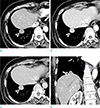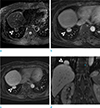Abstract
Supradiaphragmatic liver is a rare condition. Establishing an accurate preoperative diagnosis is difficult. Operative exploration is necessary to differentiate this lesion from intrathoracic masses, such as a pleural based tumor, diaphragmatic tumor and peripheral lung tumor. However, with the aid of the hepatocyte-specific magnetic resonance imaging contrast agent, gadoxetic acid (Gd-EOB-DTPA), functional hepatocytes in the lesion can be identified in the hepatobiliary phase, potentially allowing an accurate and non-invasive diagnosis. We report a case of supradiaphragmatic liver diagnosed by Gd-EOB-DTPA-enhanced magnetic resonance imaging.
Supradiaphragmatic liver is uncommon, with only a small number of cases reported (1, 2, 3, 4, 5, 6, 7, 8, 9). This rarity makes it difficult to obtain an accurate diagnosis preoperatively. The majority of the cases have been misdiagnosed as intrathoracic masses including a pleural-based tumor, diaphragmatic tumor and peripheral lung tumor. Final diagnosis is usually confirmed after surgery (1, 2, 3). Because gadoxetic acid (Gd-EOB-DTPA), which is a hepatocyte-specific magnetic resonance imaging (MRI) contrast agent, makes it possible to identify the functional hepatocytes in the hepatobiliary phase preoperatively, a non-invasive diagnosis of supradiaphragmatic liver can be made. We describe a case of supradiaphragmatic liver diagnosed by liver MRI using the gadoxetic acid.
A 57-year-old woman was referred from the emergency department for treatment of upper respiratory infection symptoms. The patient's past medical history was significant with Sheehan's syndrome and a wedge lung resection for pneumothorax approximately 30 and 15 years ago respectively. On patient's previous surgical report, no abnormal finding was found on any side of diaphragm in the operative field.
A chest radiograph showed an incidental radio-opaque round nodule nearly 2 cm in size in the right lower lung zone. High-resolution computed tomography (CT) revealed a well-defined enhancing nodular lesion in the right lower lobe near the diaphragm. Surgery was considered in suspicion of a peripheral lung mass or pleural based tumor. Since the possibility of a hepatic originated tumor could not be excluded, a dynamic liver CT scan (Somatom, Sensation, Siemens, Forchheim, Germany) was performed. The lesion showed a similar degree of dynamic enhancement to that of normal liver parenchyma (Fig. 1a-c). A pedicle with bridging vessel from the liver was also discovered (Fig. 1d). The findings indicated that the tumor originated from the liver. Besides, hepatic adenoma and focal nodular hyperplasia were included as differential diagnosis. Despite its rarity, supradiaphragmatic liver was also a candidate for differential diagnosis.
For confirmative diagnosis, liver dynamic MRI (3.0T, Intra Achieva; Philips Medical Systems, Best, Netherlands) with Gd-EOB-DTPA (0.25 mmol/mL, 10 mL bolus injection, Primovist, Bayer Schering Pharma, Berlin, Germany) was conducted. The supradiaphragmatic lesion showed isosignal intensity in spectral presaturation inversion recovery T2-weighted images (SPIR, slice thickness = 3 mm, FOV = 313 × 340 mm, matrix = 340 × 127, gap = 1 mm, TR/TE = 1964/70 ms) (Fig. 2a) and a similar degree of dynamic enhancement to that of liver parenchyma in multiphase contrast-enhanced three-dimensional (3D) T1 weight images (spoiled gradient-echo sequence, THRIVE, flip angle = 10°, slice thickness = 4 mm, interpolated slice thickness = 2 mm, FOV = 313 × 340 mm, matrix = 228 × 201, TR/TE = 3/1.5 ms) (Fig. 2b). The supradiaphragmatic lesion showed the same amount of contrast uptake as other liver parenchymata in hepatobiliary phase (Fig. 2c, d). These findings led to a diagnosis of supradiaphragmatic liver, and the possibility of hepatic adenoma or focal nodule hyperplasia was eliminated. Since it was newly appeared condition on previously healthy diaphragm, it is regarded as acquired pathology such as iatrogenic diaphragmatic liver herniation.
The patient did not undergo surgical intervention because there was no related symptom. She was discharged after treatment of bronchitis.
Supradiaphragmatic liver may be congenital or acquired (4). In the case of a congenital pathology, it is either attached through the defect on diaphragm to the liver by pedicle which contains artery, vein and bile duct or completely separated from the liver (1). When transdiaphragmatic pedicle is the case, the embryonic anomaly can be possibly explained as a focal proliferation of hepatic tissue into the thoracic cavity before complete closure of diaphragmatic membrane (5). Cases with intact diaphragm are caused likely due to atrophic change or regression of pre-existing transdiaphragmatic pedicle or development of new independent separated hepatic bud (3, 5).
Acquired supradiaphragmatic liver is associated with previous trauma. Right-sided diaphragmatic hernia is usually known to develop after penetrating or blunt trauma. Herniation of liver alone, however, is relatively uncommon (6). According to clinical presentation, traumatic diaphragmatic rupture can be divided into acute, latent and obstructive phases (6). Small herniation of liver is typically asymptomatic, and its diagnosis can be delayed for many years (7). In this case, because diaphragm was normal in the operation field and the supradiaphragmatic liver occurred later after surgery, diaphragmatic injury associated with wedge resection was the main cause of the condition.
Being an unusual condition, an accurate preoperative diagnosis of supradiaphragmatic liver is difficult. It is found incidentally in chest radiographs as a nonspecific round radio-opaque mass. In enhanced CT scans, it is identified as a homogeneously enhancing, well-defined solid lesion. Therefore, it can be mistaken for intrathoracic tumors, such as benign fibrous tumor of pleura, diaphragm and pericardium depending on its location (2, 3, 5, 8). In non-transdiaphragmatic pedicle cases, accurate preoperative diagnosis is even more difficult. The present case was first thought to be an intrathoracic mass. However, in dynamic liver CT scan, the attenuation of the lesion seemed similar to that of normal liver in dynamic phases. A coronal reformatted image from the dynamic liver CT illustrated bridging vessel from liver to the lesion, which suggested the presence of heterotopic liver.
Gd-EOB-DTPA is a contrast agent that has characteristics of both nonspecific extracellular and hepatocyte-specific agents. The presence of a lipophilic EOB group allows its translocation into the functional hepatocytes by organic anion transporting polypeptides, as well as its excretion from the hepatocytes into the bile canaliculi via multidrug resistance-associated proteins. Hepatocytes in the heterotopic liver would behave like normal hepatocytes. In the hepatobiliary phase, comparison with the signal intensity of normal liver parenchyma verifies the presence of functional hepatocytes. Through this additional liver dynamic MRI with hepatocyte-specific contrast agent, it was possible to make the correct diagnosis in this case.
When supradiaphragmatic liver occurs to an adult, it is usually asymptomatic or merely nonspecific chest pain (2, 3). Surgical resection seems unreasonable. On the contrary, for pediatric patients, especially neonates, respiratory distress is common. Immediate surgery is required (1, 4, 9). Thus, observation and conservative treatment were recommended in the present case.
In conclusion, supradiaphragmatic liver, despite its uncommon occurrence, is advised to be taken into account in differential diagnosis, particularly when a mass adjacent to the diaphragm displays a pedicle or similar homogeneous enhancement in comparison with liver parenchyma. Dynamic liver MRI with the hepatocyte-specific agent, Gd-EOB-DTPA, can be crucial for diagnosing supradiaphragmatic liver and avoiding both unnecessary surgical procedures and potential post-operative complications.
Figures and Tables
 | Fig. 1Supraddiaphgramatic liver in a 57-year-old woman.a-d. Dynamic liver CT images after contrast injection demonstrate a well-defined nodular mass (arrowheads) near the diaphragm. The mass shows similar dynamic enhancement to that of liver in arterial phase (a), portovenous phase (b) and delayed phase (c). Bridging vessel (arrow) from liver is visualized on coronal reformatted image of arterial phase (d).
|
 | Fig. 2Supraddiaphgramatic liver in 57-year-old woman.a. Fat saturated T2-weighted (SPIR, slice thickeness = 3 mm, TR/TE = 1964/70 msec) axial MR images demonstrate the supradiaphragmatic mass (arrowheads) with isosignal intensity comparable to liver parenchyma. b. In contrastenhanced 3D T1 weight images (Gd-EOB-DTPA, flip angle = 10°, TR/TE = 3/1.5 msec), the supradiaphragmatic mass (arrowheads) showed similar dynamic enhancement (portal phase, which is 2 minutes after contrast injection, is shown). c, d. In the hepatobiliary phase (20 minutes after contrast injection), the supradiaphragmatic mass (arrowheads) exhibits the same amount of contrast uptakes comparable to liver parenchyma. SPIR = spectral presaturation inversion recovery
|
References
1. Choi SU, Kim HK, Kim J. Heterotopic supradiaphragmatic liver combined with intralobar pulmonary sequestration. Ann Thorac Surg. 2008; 85:1809–1810.
2. Chen YY, Huang TW, Chang H, Hsu HH, Lee SC. Intrathoracic caudate lobe of the liver: a case report and literature review. World J Gastroenterol. 2014; 20:5147–5152.
3. An J, Han J, Lee KS, Choi YS. Supradiaphragmatic heterotopic liver presenting as a pleural mass: a case report. Tuberc Respir Dis. 2010; 69:191–195.
4. Kurt A, Yazıcıoğlu KR, Tosun Ö, Coşkun M. Right sided diaphragmatic hernia in an adult without history of trauma: Unusual CT findings. Eur J Gen Med. 2004; 1:55–57.
5. Mendoza A, Voland J, Wolf P, Benirschke K. Supradiaphragmatic liver in the lung. Arch Pathol Lab Med. 1986; 110:1085–1086.
6. Agha FP. Transdiaphragmatic liver hernia in adults. Australas Radiol. 1985; 29:19–25.
7. Sato K, Orihashi K, Hamanaka Y, et al. Post-traumatic diaphragmatic herniation of the liver, examined by positron emission tomography: case report. World J Emerg Surg. 2011; 6:30.
8. Luoma R, Raboei E. Supradiaphragmatic accessory liver: a rare cause of respiratory distress in a neonate. J Pediatr Surg. 2003; 38:1413–1414.
9. Kinnunen P, Kulmala P, Kaarteenaho-Wiik R, Vuopala K. Ectopic liver in the human pericardium. Histopathology. 1997; 30:277–279.




 PDF
PDF ePub
ePub Citation
Citation Print
Print


 XML Download
XML Download